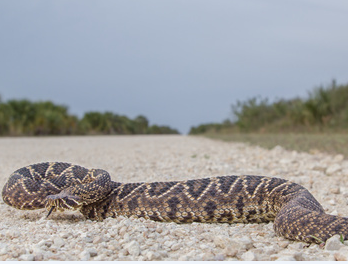

Although the rattlesnake species numbers are in decline, there are still plenty of rattlesnakes in the Florida region. There are relatively few deaths attributed to rattlesnake bites in the United States each year due to the easy availability of medical care and advances in medical treatments. Add to this that there are only about 8,000 rattlesnake bites reported per year in the US, so even the chances of getting bit are relatively low. But when it comes to any of the rattlesnakes found in Florida, it’s still far better to be educated and ready to react just in case you should encounter one.
Protecting your loved ones
Dogs, cats and children are sometimes the most at risk from rattlesnakes. This is because their curiosity may overtake their fear of seeing a snake. They may not know enough to back away, so it’s important to take some preventative measures.
Rattlesnakes do not generally like to be inside, so you want to focus on the outside. Keep your yard as “snake-proof” as possible. They like places where they can hunker down and hide, so remove any tall grasses, overgrown bushes or piles of debris. Make sure your dogs are kept on leashes and your children kept in your sight.
What to do if you see one
If you run into a rattlesnake, you may hear the tell-tale rattle or buzzing sound. If the snake thinks you haven’t seen it yet, it may not start rattling, but you should still be able to tell because the tail end is not pointy and smooth. Their tail end is the rattle.
However, unless you really know your snake species and can tell venomous from non-venomous snakes, your best bet is to leave them all alone. Simply walk away as quietly and gently as you can. Once you are far enough away, you can start making noise or agitating things in order to get the snake to leave on its own.
Most people who do get bit by a rattlesnake do so because they attempt to move or kill the snake. Even though you may not like the snake, going after it with the hoe is a bad idea. Any time there is contact between a human and a rattlesnake, the chances of you getting bit get much higher.
What to do if you get bit
Certainly, the first thing you should do is to get away from the snake. They are known to bite multiple times, so it’s best to put a good bit of distance between you and the snake.
Your next step is to call 911 and report an emergency medical situation. Make sure to tell them everything about the snake you can. Keep the bitten area lower than the victim’s heart and remove anything that might be constrictive as the area will become swollen.
Do NOT try to suck out the venom, apply a tourniquet or any of the other “traditional” treatments. They simply do not work and could make things much worse.
